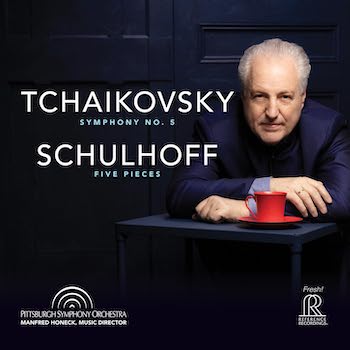Classical Album Review: Manfred Honeck Conducts Tchaikovsky and Schulhoff — It’s a Doozy!
By Jonathan Blumhofer
This is a Tchaikovsky Fifth that’s thoroughly lived in.
 Tchaikovsky’s Fifth Symphony occupies a special place for Manfred Honeck and the Pittsburgh Symphony: it was the first major piece the conductor led with the orchestra when he first conducted them in 2006. Now, after fifteen years as Pittsburgh’s music director, Honeck & Co. have returned to document the score on a new album for Reference Recordings.
Tchaikovsky’s Fifth Symphony occupies a special place for Manfred Honeck and the Pittsburgh Symphony: it was the first major piece the conductor led with the orchestra when he first conducted them in 2006. Now, after fifteen years as Pittsburgh’s music director, Honeck & Co. have returned to document the score on a new album for Reference Recordings.
It’s a doozy.
For one, this is a Tchaikovsky Fifth that’s thoroughly lived in. Honeck’s got the orchestra closely observing all the details on the page. But the account isn’t one that’s beholden to the letter of the score for its own sake and, to be sure, the conductor isn’t afraid to take liberties with dynamic phrasings at climaxes or to underline key structural moments.
None of his choices, though, feel or sound unmusical. Rather, they heighten the excitement and push the score’s utilization of rhetoric and tone color to the fore. In the first movement, for instance, plushness and exquisite tonal blend (among the woodwinds, especially) never come at the cost of the imperative of the singing line.
The opening of the Andante, with its luminous horn and clarinet solos is breathtakingly conversational. Though the movement’s ffff indications don’t seem as commensurately loud as the pppps are quiet (Honeck draws some astonishingly soft playing from the Pittsburghers), balances are spot-on and the performance flows with unfettered ease.
So, too, the Scherzo, which actually moves like a true waltz, shapely and graceful as ever. The finale, with its taut rhythmic figures and blazing coda, wraps the whole enterprise up in, as it were, an ecstatically colored bow.
At first glance, the pairing of the Tchaikovsky with Erwin Schulhoff’s acerbic Five Pieces may seem odd. But the fact is that this Fifth runs so close to the edge that, come the double bar, there still is tension to spare. That’s released in this orchestral arrangement (by Honeck and Tomás Ille) of what was originally a string quartet.
The transcription is fresh and bracing, often sounding a bit like Bartók at his less austere (the Prague-born Schulhoff was about a decade younger than his Hungarian contemporary). Highlights include a snapping traversal of the opening “Alla Valse Viennese” and an alluring account of the rustic “Alla Serenata.”
Add to this typically informative and expansive liner notes by the conductor (sixteen pages this time; no other major orchestral music director regularly invests such care in conveying their interpretive ideas in a CD booklet as Honeck does), and we’ve got another engrossing, terrifically played Pittsburgh SO release. Don’t miss it: the Honeck/Pittsburgh partnership – thankfully, well-documented – is simply one of the best there is.
Jonathan Blumhofer is a composer and violist who has been active in the greater Boston area since 2004. His music has received numerous awards and been performed by various ensembles, including the American Composers Orchestra, Kiev Philharmonic, Camerata Chicago, Xanthos Ensemble, and Juventas New Music Group. Since receiving his doctorate from Boston University in 2010, Jon has taught at Clark University, Worcester Polytechnic Institute, and online for the University of Phoenix, in addition to writing music criticism for the Worcester Telegram & Gazette.
Tagged: Manfred Honeck, Pittsburgh Symphony Orchestra
